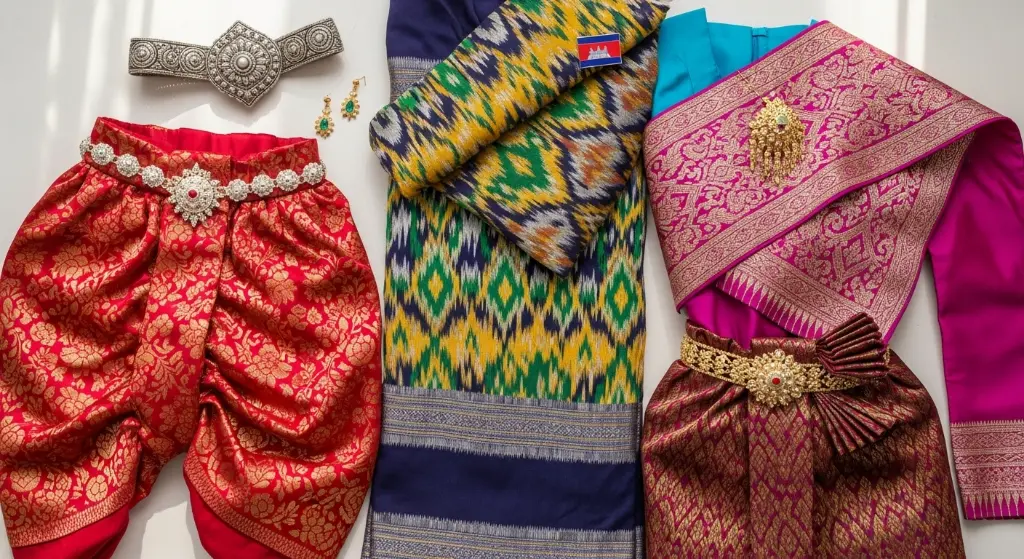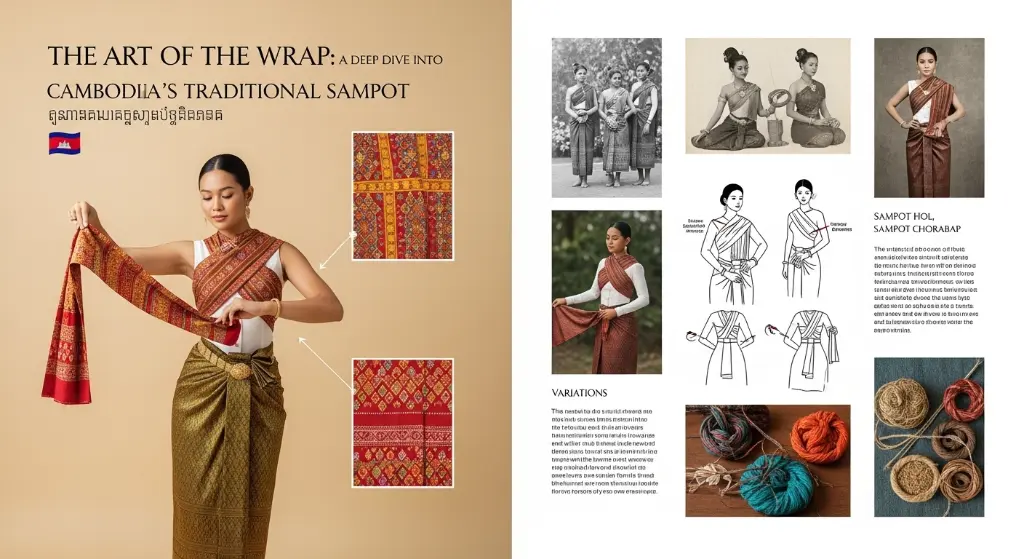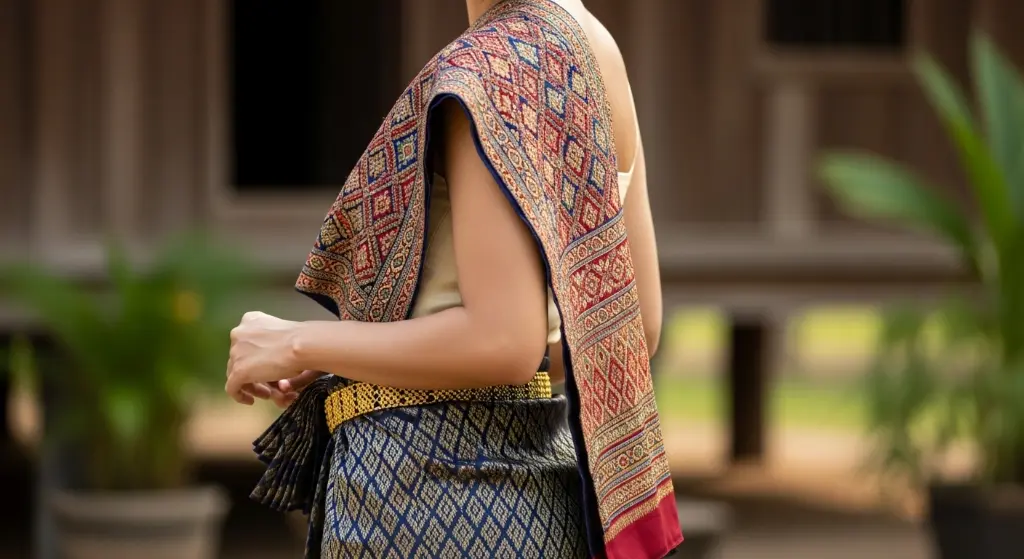Woven in Gold: The Sampot and the Story of Cambodian Silk
Trace your fingers over the sandstone galleries of Angkor Wat, and you will feel them: celestial dancers, the divine Apsaras, frozen mid-twirl for a thousand years. Their stone bodies are wrapped in textiles of impossible detail, a silent, eternal fashion show. For centuries, they were a ghostly echo of a lost golden age. But look closer. That garment is not a ghost. It is alive. You can see it today, shimmering in the real world like a captured sunbeam, in the impossibly vibrant silks of a bride on her wedding day. You can hear its soft rustle in the reverent quiet of a pagoda. 🙏
This is the Sampot, Cambodia’s national soul made manifest in cloth—a garment that carries the grandeur of an empire, the agony of a genocide, and the defiant, breathtaking beauty of a culture that refused to die.
This article will guide you through the rich and complex world of the traditional Cambodian Sampot. We will explore its ancient origins, the legendary skill of Khmer weavers 🧵, the different styles for every occasion, and its incredible journey of survival.

📜 The Khmer Identity Woven in Cloth: What is a Sampot?
At its most fundamental, the Sampot (សំពត់) is not a tailored garment. It is a magnificent rectangle of cloth, typically 3 to 4 meters long, that is masterfully wrapped around the lower body. Its genius lies in its versatility; the same cloth can be a simple skirt for daily life or pleated into elegant, pant-like trousers for the grandest ceremonies.
See also Traditional Clothing in Japan
Traditional Clothing in JapanEchoes of Ancient India & A Khmer Origin Myth 🌊👑
The Sampot’s story begins over two thousand years ago, woven into the great tapestry of trade and culture that connected Southeast Asia to India. Its roots lie in the Funan Kingdom, where the Indian practice of wearing wrapped garments like the dhoti was first introduced.
A beloved Khmer legend brings this history to life. It tells of an Indian Brahman, Kaundinya, who arrived on Cambodia’s shores and was met by the land’s ruler, the serpent-princess Soma. After a display of power, Kaundinya fell for the princess. As a gesture of profound respect, he draped her in a beautiful piece of cloth he had brought with him—the very first Sampot. Their marriage symbolized the birth of Khmer culture, uniting foreign knowledge with local spirit. This myth beautifully captures the essence of the Sampot: a garment with ancient regional roots that became uniquely, fiercely Khmer.

✨ The Golden Thread: Cambodian Silk and the Art of Weaving
To speak of the Sampot is to speak of silk. And not just any silk. Cambodia is home to a native silkworm that produces a uniquely textured, naturally golden-hued silk. This “golden silk” is the heart of the most exquisite Khmer textiles, renowned for its shimmering luster and remarkable strength. The creation of a Sampot is an act of devotion, a heritage passed from mother to daughter through generations.
The Magic of Ikat: The Sampot Hol 🎨
The Sampot Hol (សំពត់ហូល) is the pinnacle of Khmer weaving, a textile art form that feels like pure magic. It is created using ikat, a resist-dyeing technique of breathtaking complexity. The pattern is dyed onto the threads before they are ever placed on the loom.
See also Traditional Japanese Clothing: Yukata
Traditional Japanese Clothing: YukataThe Ikat Process is a meditation in thread:
- Tying ➰: A master weaver stretches bundles of silk weft threads on a frame. With hands that move with ancestral memory, she meticulously ties off tiny sections with banana fibers, creating a secret code based on the pattern she holds in her mind.
- Dyeing 🌈: The threads are plunged into bubbling cauldrons of natural dye. The tied sections resist the color, remaining pristine. For a multi-hued pattern, this process is repeated—untying, re-tying, and dipping in the next color—an incredible feat of precision.
- Weaving 👩🎨: Once all the colors are set, the ties are removed, revealing threads painted with the ghosts of the pattern. The weaver then takes these threads to her loom. As she works, the pre-dyed sections align with impossible accuracy, and the intricate design—a sacred naga, a diamond, a star—emerges from the chaos, a pattern born from pure vision.
A single Sampot Hol can take months to complete, making each one a priceless work of art.
The Luxury of Twill: The Sampot Phamuong 💎
The Sampot Phamuong (សំពត់ផាមួង) is a different kind of masterpiece. It is a single-color or two-toned fabric, whose beauty lies in its heavy, luxurious drape and deep, solid colors. Woven in a twill pattern, it often features two different colors in the warp and weft, creating a stunning iridescent effect that shifts with every movement. For royal ceremonies, weavers would incorporate threads of genuine gold or silver, turning the garment into pure treasure.
A Sampot for Every Occasion 💃🕺
The Sampot is a rich and varied wardrobe in a single concept. The style worn immediately communicates status, occasion, and identity.
| Sampot Type | Description | Primary Use | Worn By |
|---|---|---|---|
| Sampot Chang Kben | A long cloth expertly wrapped and pleated to resemble trousers. | Formal wear, classical dance, historical uniforms. | Upper-class men & women; modern brides & grooms. |
| Sampot Hol | A wrap-around skirt made from patterned ikat silk. | Ceremonial dress, weddings, holidays. 🎊 | Primarily women. |
| Sampot Phamuong | A wrap-around skirt of heavy, single-color twill silk. | Formal and ceremonial wear. | Primarily women, often of high status. |
| Sampot Tep Apsara | The style seen on Angkor’s celestial dancers. | Historical representation, classical dance. ✨ | Apsara dancers. |
| Sampot Sâng | A simple, everyday cotton sampot. | Daily wear, rural work. | Men and women of all classes. |
The Sampot Chang Kben: The Regal Pant-Like Drape 👖
Perhaps the most iconic style, the Sampot Chang Kben is a marvel of non-sewn tailoring. The wearer wraps the cloth, twists the front into a thick pleat, pulls it between the legs, and tucks it securely at the back. This creates a garment that is both elegant and practical, allowing for freedom of movement. Once the dress of kings and warriors, it is now reserved for the most sacred moments in life and art.
🗣️ The Language of the Loom: Symbolism and Social Status
In Khmer culture, clothing is a language. The Sampot speaks volumes.
- Material: Cotton was for labor. Silk was for power, ceremony, and leisure. Threads of real gold and silver were the exclusive domain of royalty. 👑
- Patterns: The motifs in a Sampot Hol are deeply spiritual. The naga (a mythical serpent) offers protection. Flowers and stars connect the wearer to the heavens and the earth. 🐍✨
- Colors: Traditionally, certain colors were worn on specific days of the week, a sign of courtly sophistication. For example, Sunday was red ❤️, while Monday was a vibrant chartreuse-yellow 💛.

🎗️ A Story of Survival: From Angkor to the Killing Fields and Back
The history of the Sampot is a powerful metaphor for Cambodia itself—a story of soaring achievement, devastating loss, and awe-inspiring resilience. After the glory of Angkor faded, the art of weaving endured for centuries.
The Cultural Genocide of the Khmer Rouge 💔
Then came the darkness. Between 1975 and 1979, the Khmer Rouge regime sought to obliterate Cambodia’s culture. Artisans, dancers, and scholars were targeted for extermination. The master weavers, who held lifetimes of knowledge in their hands, were murdered. The looms fell silent. The vibrant Sampot, and the souls who created it, were pushed to the very edge of extinction.
The Modern Revival 🌱
After the regime fell, Cambodia began the monumental task of healing. A crucial part of this was reviving its shattered arts.
- A handful of surviving master weavers began the slow, patient process of teaching a new generation.
- NGOs and international patrons established weaving centers, providing not just training but economic lifelines to rural women.
- The Cambodian government and Royal Family championed silk weaving as a vital piece of the national identity.
Today, the Cambodian Sampot is experiencing a vibrant renaissance. It is a source of immense national pride and a mandatory part of formal life. The looms are singing again.

A Nation’s Identity in Every Thread
The Sampot is far more than a beautiful piece of clothing. It is a library of cultural knowledge, a canvas for breathtaking artistry, and a symbol of a nation’s unbreakable will to live. From the ancient Sampot Chang Kben to the story-filled Sampot Hol, each wrap and fold is a connection to a profound history.
Having survived the fall of an empire and the horror of a genocide, the shimmering silks of the Sampot are a powerful statement. They declare that even after the darkest of times, beauty can be re-woven, traditions can be reborn, and a culture’s golden threads can never truly be broken. The Sampot is, in every sense of the word, the fabric of Cambodia. 🇰🇭❤️
Which Sampot style or weaving technique do you find most fascinating? Share your thoughts in the comments below! 👇 Pass this story of cultural survival on, and subscribe for more journeys into the world’s most meaningful traditions.
